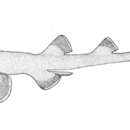en
names in breadcrumbs


Hasselt's bamboo shark (Chiloscyllium hasseltii) is a bamboo shark in the family Hemiscylliidae found around Thailand, Malaysia and Indonesia, between latitudes 23° N and 10° S, and longitude 91° E and 133° E; residing inshore. Its length is up to 60 cm.
Features: Much like C. punctatum, adults usually have no color patterns, but the juveniles have transverse dark bands with black edging.[2]
Reproduction: These sharks are oviparous. The eggs will attach to benthic marine plants and hatch in December. Their average size at hatching is 94 to 120 mm.[2]
{{cite journal}}: CS1 maint: multiple names: authors list (link) Hasselt's bamboo shark (Chiloscyllium hasseltii) is a bamboo shark in the family Hemiscylliidae found around Thailand, Malaysia and Indonesia, between latitudes 23° N and 10° S, and longitude 91° E and 133° E; residing inshore. Its length is up to 60 cm.
Features: Much like C. punctatum, adults usually have no color patterns, but the juveniles have transverse dark bands with black edging.
Reproduction: These sharks are oviparous. The eggs will attach to benthic marine plants and hatch in December. Their average size at hatching is 94 to 120 mm.